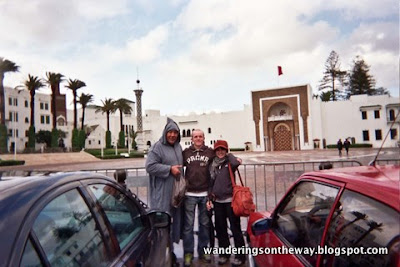Morocco is a very cool place, but be prepared; some of the choices we made could have gone horribly wrong. You really shouldn't accept someone to guide you, you should never go into a carpet shop unless you're a Berber-bargaining expert, and you should always wear boots. Also, get a good rated disposable camera. I was not to keen on bringing in my expensive digital SLR, so I bought a disposable. Unfortunately, I traded off some great shots.
The photos below are not very sharp, but I suppose it captures the old, muddled, grittiness that epitomised the charm of Morocco's ancient capital, Tetouan.

There are two parts of the city: the old and new. The newer part is really only newer in comparison, though. It was built by Spanish settlers a few hundred years ago. The older part of the city, the entrance to which is shown above, is residential and the market centre. There are Christian (very small), Jewish, and Muslim sections in both the old and new parts. The pictures did not print, but the mountains surrounding the city were simply majestic, especially when the rain ceased and the fog pulled back to reveal the surrounding peaks.
In the market. You can see how the little girl is dressed in a pretty modern jacket and the man and woman in more traditional Berber fashion. The city seems to have its feet in two different places - the past and the present. All the young were dressed very modernly but there was still all the old fashioned attitudes towards women and such.

You can see the mountains in the distance. We were told by our guide that the day we were in town was when the craftsmen from the market came to the market to sell crafts and such. We're not sure if this was exactly true, or just a ploy to get us to buy souvenirs. Either way, we did get quite a few things and was hopefully only drastically conned once. :-P

Man spinning a tapestry. Many people still hand-make their clothes and food. This made it really feel like you were going back in time. However, it didn't give off the impression of poverty. As you can tell by the congenial grin of the man above, people were on the whole pretty happy. This was especially the case with our guide, who seemed to know everyone in the city and was happy to greet them all and introduce them to us. He explained to us that people are not as rich here as they are in the West, but on the whole people have food and thus they are not inclined towards violence and hostility. He said that this did, however, become more problematic as one traveled south into what he called "Black Africa", which struck me as unusual. I had always assumed all Africans thought of themselves as African, but I felt his comment was slightly belittling and racist. Clearly racial/ethnic divides are everywhere.

Dyeing wool for rugs. Moroccan rugs are really unique and cool looking, though I think Caspian rugs are nicer. Berber rugs are made mostly from wool so they're rougher, but this would be useful in the variable terrain Berber tribes traveled and farmed.
Selling beans and seeds. The streets were packed with stands, shoppers, and people pushing make-shift carts. The first Arabic Muhammad taught us was what a person says when they are trying to push a cart through a crowd. One carter didn't at one point and rammed his wagon into Muhammad while he was giving me an olive to taste and he fell right into me! AWKWARD. I think he yelled some nasty things at the kid in Arabic though...
The green down the alley ways was so gorgeous. Muhammad told us that the houses were around 400 years old each, which he told us as were were walking under one!
These rocks are ground and combined with water to make paint.

Some small boys who were staring me down. Though I'd get a picture- they were pretty darn cute. I found men there to be very forward.
Ross and myself with our guide Muhammed in front of the museum, Spanish influenced architecture. I think this part began the 'new' city.
Men drinking mint tea. I stupidly asked if it was alcoholic, but of course alcohol is not allowed in Muslim countries!

Government building, I believe.
Man making bread.

Staircase.
Ross and I will return someday to Morocco and we recommend going there if you ever get the chance.
-2.jpg)
-1.jpg)
.jpg)


.jpg)
.jpg)
+copy.jpg)
.jpg)
.jpg)
.jpg)
.jpg)
.jpg)
+copy.jpg)
.jpg)
.jpg)
.jpg)
+copy.jpg)
.jpg)
.jpg)
.jpg)






-4.jpg)
-5.jpg)
.jpg)
-3.jpg)
-2.jpg)
.jpg)
-2.jpg)
.jpg)
.jpg)
.jpg)
.jpg)
.jpg)
.jpg)
.jpg)
.jpg)
-2.jpg)
.jpg)

















